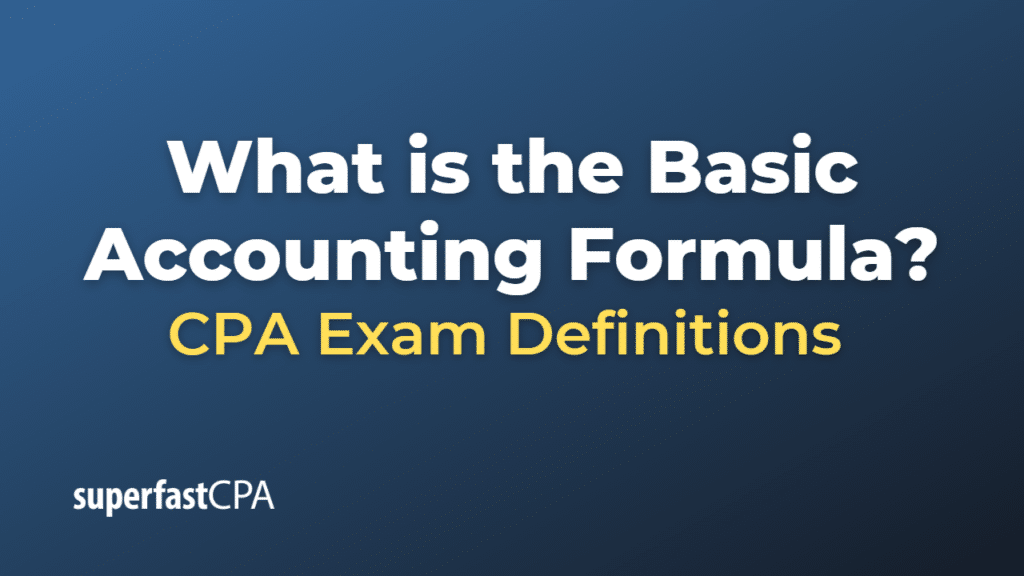Basic Accounting Formula
The basic accounting formula, also known as the accounting equation, is a fundamental principle that underlies the double-entry bookkeeping system used in accounting. The formula is as follows:
Assets = Liabilities + Owner’s Equity
The formula represents the relationship between a company’s assets, liabilities, and owner’s equity at a specific point in time. It serves as the foundation for the balance sheet, which is one of the main financial statements that provide information about a company’s financial position.
Here’s a brief explanation of each component of the formula:
- Assets: Assets are the resources a company owns or controls that have future economic value. Assets can be tangible, such as cash, inventory, or property, or intangible, such as patents, copyrights, or goodwill.
- Liabilities: Liabilities are the company’s financial obligations or debts that arise from its business activities. They represent amounts owed to creditors, suppliers, or other parties and can include accounts payable, loans, or bonds.
- Owner’s Equity: Owner’s equity, also known as shareholder’s equity or net assets, represents the residual interest in the assets of a company after deducting its liabilities. In other words, it is the portion of the company’s assets that belongs to the owners or shareholders. Owner’s equity includes contributed capital (such as common stock) and retained earnings (which represent profits that have not been distributed as dividends).
The basic accounting formula ensures that a company’s financial records are always in balance, as every financial transaction affects at least two accounts (one on each side of the equation). This principle of double-entry bookkeeping helps maintain accuracy and consistency in accounting records and facilitates the preparation of financial statements.
Example of the Basic Accounting Formula
Let’s consider a fictional example of a small business called “John’s Bike Shop” to illustrate the basic accounting formula in action.
John starts his bike shop by investing $50,000 of his own money. The basic accounting formula at this point looks like this:
Assets = Liabilities + Owner’s Equity
$50,000 (Cash) = $0 (Liabilities) + $50,000 (Owner’s Equity)
Now, John uses $30,000 of the cash to purchase inventory (bikes, bike parts, and accessories) for his shop. After this transaction, the accounting equation looks like this:
Assets = Liabilities + Owner’s Equity
($20,000 Cash + $30,000 Inventory) = $0 (Liabilities) + $50,000 (Owner’s Equity)
Next, John takes out a bank loan of $10,000 to help cover operating expenses. The updated accounting equation is:
Assets = Liabilities + Owner’s Equity
($30,000 Cash + $30,000 Inventory) = $10,000 (Liabilities) + $50,000 (Owner’s Equity)
John then uses $5,000 of the cash to purchase store equipment (shelving, tools, etc.):
Assets = Liabilities + Owner’s Equity
($25,000 Cash + $30,000 Inventory + $5,000 Equipment) = $10,000 (Liabilities) + $50,000 (Owner’s Equity)
After a month of operations, John’s Bike Shop earns $15,000 in revenue and incurs $8,000 in expenses (salaries, rent, utilities, etc.):
Assets = Liabilities + Owner’s Equity
($32,000 Cash + $30,000 Inventory + $5,000 Equipment) = $10,000 (Liabilities) + $57,000 (Owner’s Equity)
As you can see from this example, the basic accounting formula remains in balance after each transaction, ensuring that the company’s financial records are accurate and consistent. By applying the basic accounting formula, John’s Bike Shop can maintain reliable financial records and prepare financial statements that provide essential information about its financial position and performance.













